Table of Contents
- Introduction
- Editor’s Choice
- Wearable Technology Market Overview
- Wearable Technology Statistics by Brands
- Number of Connected Wearable Devices Worldwide
- Consumer Adoption and Usage
- Consumer Response On Wearable Technology
- Shipments of Wearable Devices
- Global Spending on Wearable Devices
- Wearable Technology Usage by Country
- Barriers to Adoption of Wearables
- Recent Developments
- Conclusion
- FAQs
Introduction
Wearable Technology Statistics: Wearable technology encompasses electronic devices worn on the body. Serving various functions such as health monitoring, communication facilitation, and convenience enhancement.
These devices include smartwatches, fitness trackers, AR glasses, smart apparel, hearables, and medical wearables.
They find uses in tracking health and fitness, enabling communication, assisting with navigation, delivering entertainment, supporting workplace tasks, and enhancing healthcare services.
The wearable technology market has grown substantially, with major players like Apple and Samsung dominating the consumer wearable sector.
Challenges in this domain include privacy concerns, battery life limitations, and adherence to regulatory standards.
At the same time, future trends encompass the integration of artificial intelligence. The adoption of electronic textiles (e-textiles), and an extended role within the Internet of Things (IoT) ecosystem.
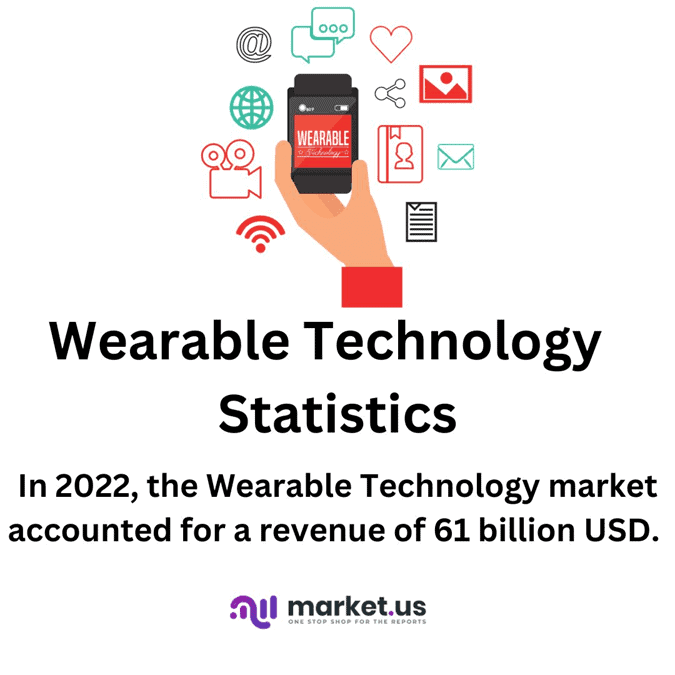
Editor’s Choice
- The wearable technology market is experiencing substantial growth at a CAGR of 14.60%. With market revenue projected to increase steadily over the next decade.
- In 2022, the wearable technology market revenue stood at USD 61.0 billion. Expected to rise to USD 231.0 billion in 2032.
- North America commands the largest share, accounting for 33.8% of the market. Showcasing a strong presence and adoption of wearable tech in this region.
- Sony Corp. is a leading market player, commanding a substantial 15% share.
- Approximately 40% of global wearable technology users find these devices indispensable, while 25% report wearing them even while sleeping.
- In 2023, Earwear devices will have 325 million shipments, commanding a substantial market share of 62.10%.
- In 2019, approximately 56.7 million individuals in the United States regularly used wearable devices.
- During the same year, the sales of health wearables reached a substantial 223 million units, which has risen.
- Moving into 2020, shipments of wearables surged to 368.2 million units. Indicating a significant increase in adoption and demand for these devices.
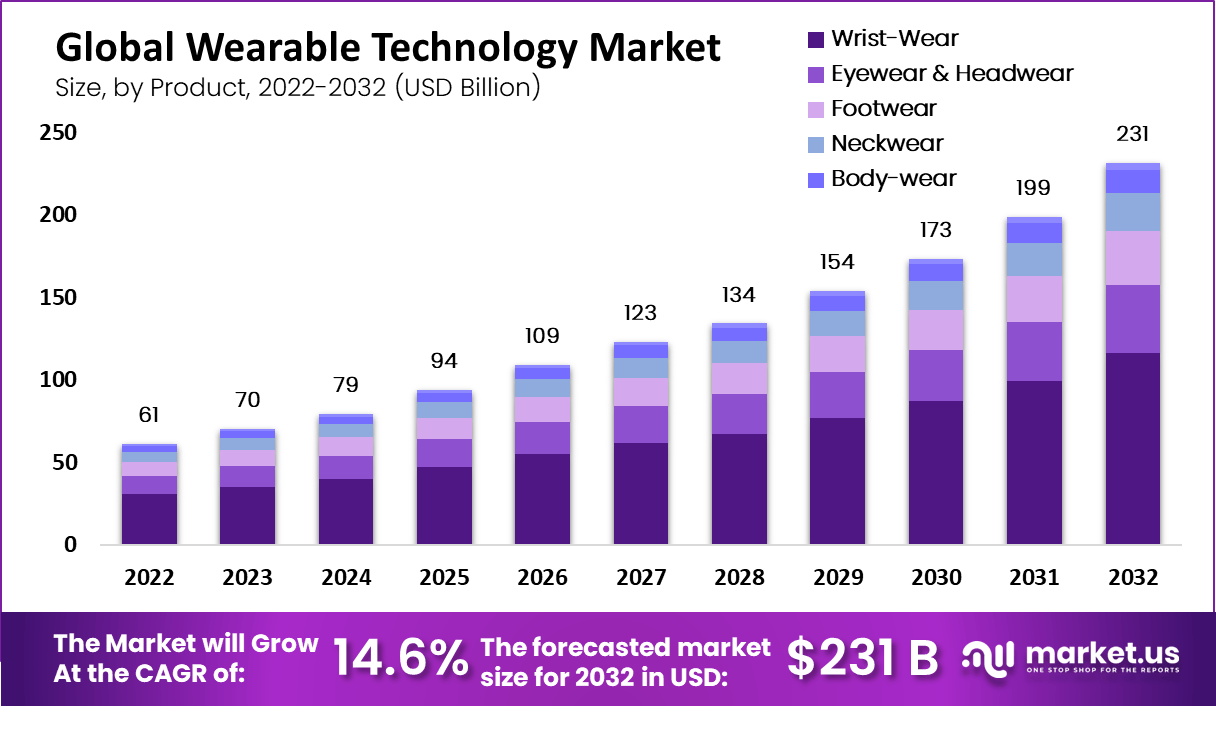
Wearable Technology Market Overview
Global Wearable Technology Market Size Statistics
- The wearable technology market is experiencing substantial growth at a CAGR of 14.60%. With market revenue projected to increase steadily over the next decade.
- In 2022, the market’s revenue stood at USD 61.0 billion, expected to rise to USD 70.0 billion in 2023.
- The trend continues with anticipated revenues of USD 79.0 billion in 2024 and USD 94.0 billion in 2025.
- By 2026, the market is forecasted to reach USD 109.0 billion, and this upward trajectory persists with revenues of USD 123.0 billion in 2027 and USD 134.0 billion in 2028.
- The growth becomes even more pronounced as we look ahead to 2029. With a projected revenue of USD 154.0 billion, 2030 is expected to see a significant milestone with revenue reaching USD 173.0 billion.
- This upward trajectory continues through 2031 and 2032, with market revenues estimated to be USD 199.0 billion and USD 231.0 billion, respectively.
- These figures reflect wearable technology’s growing popularity and significance in various aspects of our lives.
(Source: Market.us)
Take advantage of our unbeatable offer - buy now!

Wearable Technology Market Share – By Region Statistics
- The global wearable technology market exhibits a diversified market share distribution across different regions.
- North America commands the largest share, accounting for 33.8% of the market. Showcasing a strong presence and adoption of wearable tech in this region.
- Europe follows closely behind with a market share of 25.4%. Reflecting a significant market presence and consumer interest in wearable devices.
- The Asia-Pacific (APAC) region holds a substantial market share of 30.1%. Indicating the growing popularity and adoption of wearable technology in this dynamic and tech-savvy region.
- In contrast, Latin America and the Middle East & Africa (MEA) regions have comparatively smaller market shares, 6.9%, and 3.8%, respectively. Suggesting potential growth opportunities for wearable technology in these emerging markets.
- The market share distribution by region underscores the global appeal and diverse market landscapes for wearable technology.
(Source: Market.us)
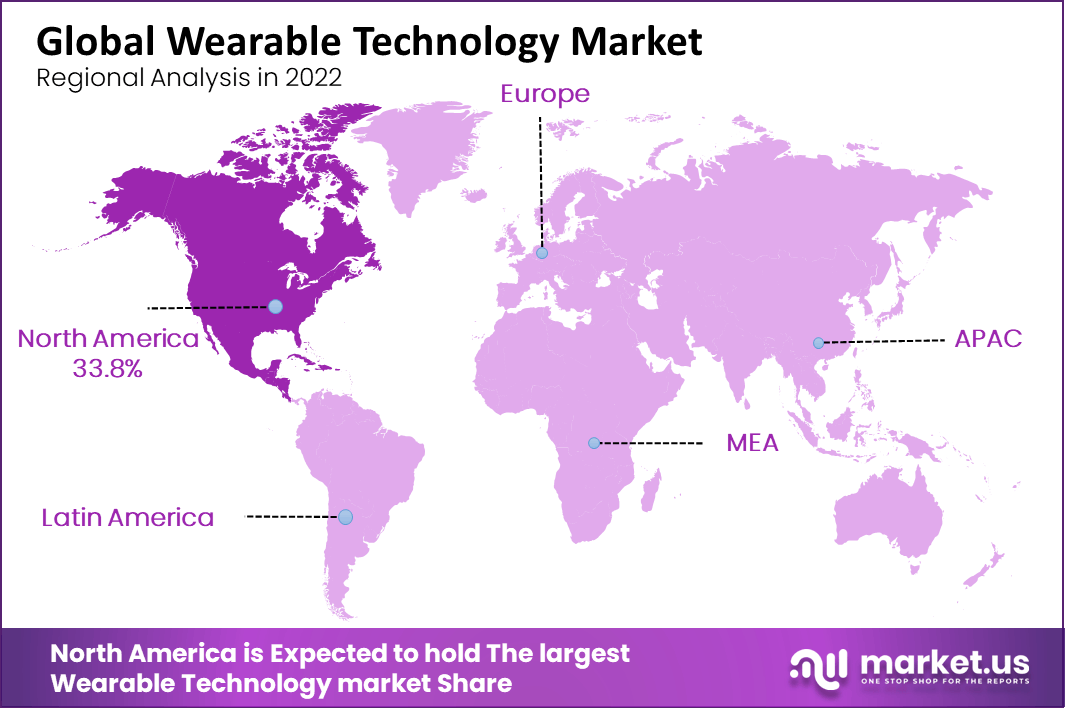
Wearable Technology Statistics by Brands
Leading Wearable Technology Companies According to Market Share Statistics
- In the highly competitive wearable technology market, various prominent companies vie for market share.
- Sony Corp. is a leading player, commanding a substantial 15% share.
- Apple Inc. and Alphabet Inc. share equal ground with 12% each, solidifying their positions as significant industry contributors.
- Huawei Technologies Group Co., Ltd. follows closely behind with an 11% market share. Samsung Electronics Co., Ltd. and Xiaomi Corp. contribute 10% and 9%, further diversifying the market.
- Meanwhile, sportswear giants Adidas AG and Nike, Inc. each claim 8% and 9% of the market share, attesting to their influence in the wearables sector.
- The remaining market share, amounting to 14%, is collectively represented by other key players. Underscoring the competitive and evolving nature of the industry, where innovation and consumer preferences play pivotal roles in market dynamics.
(Source: Market.us)

Number of Connected Wearable Devices Worldwide
- The number of connected wearable devices worldwide has shown a consistent upward trend over the years. Reflecting the growing popularity and integration of wearable technology into daily life.
- In 2019, there were 722 million connected wearables in use globally.
- This figure saw a notable increase in 2020, reaching 835 million, demonstrating a surge in adoption.
- The momentum continued into 2021, with the number of connected wearables rising to 929 million.
- As of 2022, the global market for connected wearables has expanded even further, with a remarkable 1,110 million devices worldwide.
- These numbers underscore the pervasive presence of wearable technology, which has become an integral part of the digital landscape. Catering to a wide range of applications and user preferences.
(Source: Statista)
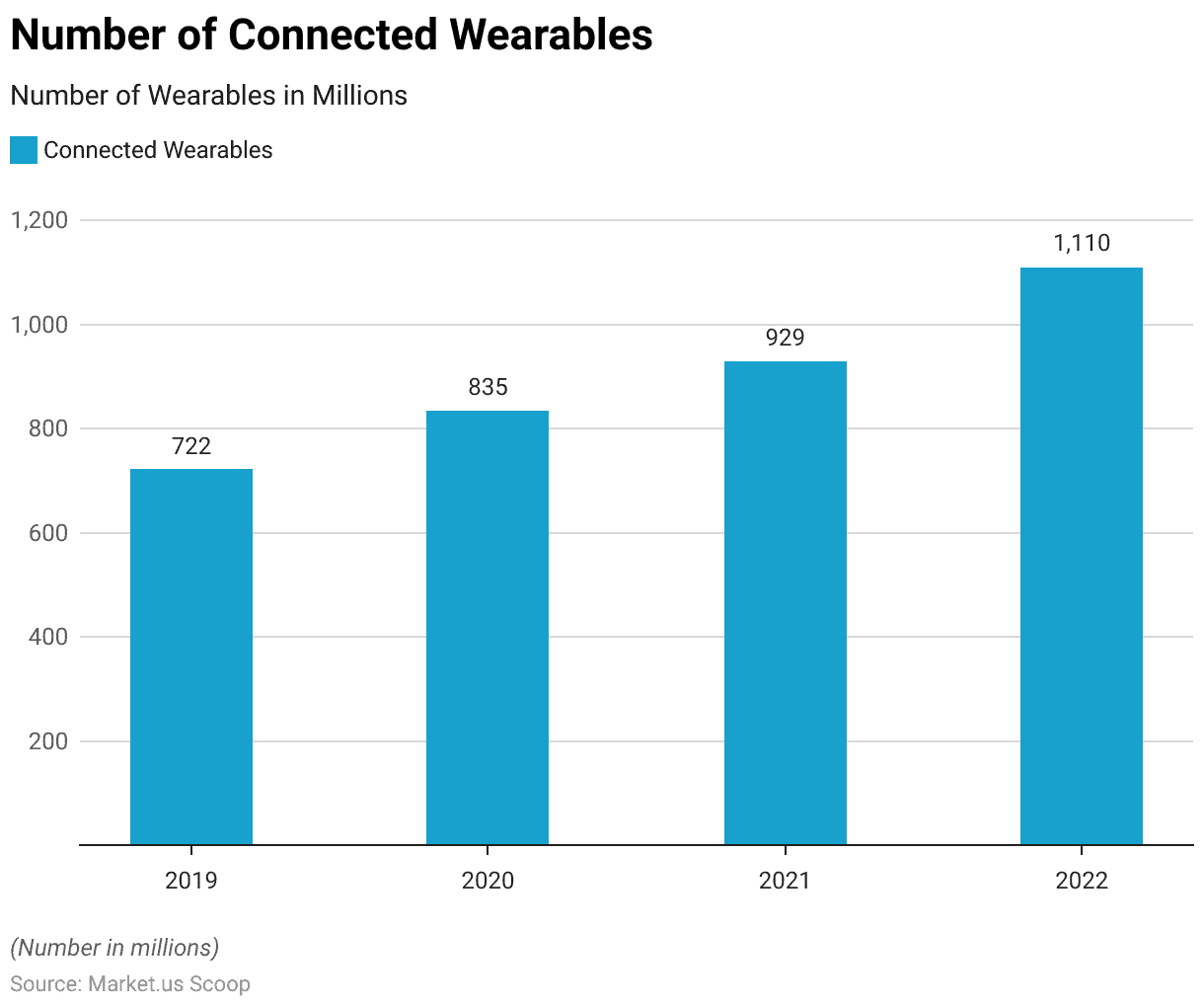
Consumer Adoption and Usage
Wearable Technology Statistics By Age
- As per a recent survey, the utilization of wearable healthcare devices in the past 12 months among different age groups presents a varied landscape.
- Among adults aged 18-34, approximately 10.2% reported using wearable healthcare devices. Indicating a relatively higher adoption rate among this younger demographic.
- In the 35-49 age group, 9.32% reported using such devices, demonstrating a comparable level of engagement. However, as the age groups progress, the adoption rates decline.
- Adults aged 50-64 had a 7.93% adoption rate, while those in the 65-74 age group reported a lower 2% usage rate.
- The trend continues as individuals reach the age of 75 and above, with an adoption rate of 0.8%.
- The higher adoption rates among younger age groups may be attributed to their greater familiarity with and interest in technology.
- At the same time, older adults exhibit lower adoption. Potentially due to factors such as limited familiarity or specific health needs.
(Source: National Cancer Institute’s Health Information National Trends Survey)
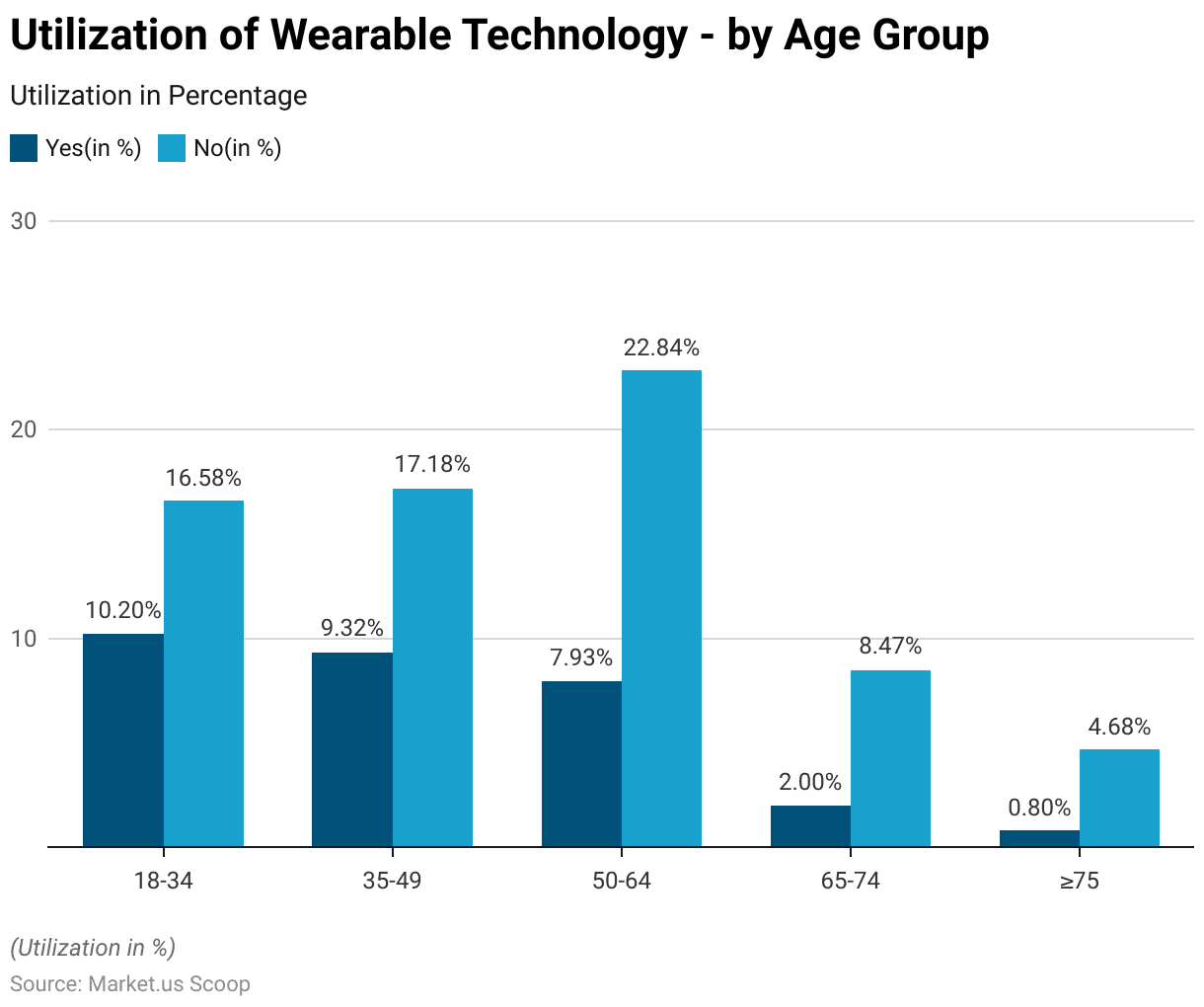
Wearable Technology Statistics By Gender
- The utilization of wearable healthcare devices in the past 12 months exhibits gender-based differences in adoption rates.
- Among males, approximately 13.54% reported using wearable healthcare devices, indicating a moderate level of engagement.
- In contrast, females showed a slightly higher adoption rate, with 16.41% reporting usage.
- Interestingly, despite this higher adoption among females, a comparable proportion of both genders, around 34-36%, reported not using such devices.
- These findings suggest that while females have a somewhat higher adoption rate, wearable healthcare devices are used by a significant portion of both male and female populations. Reflecting the broad appeal and integration of these devices into healthcare routines irrespective of gender.
(Source: National Cancer Institute’s Health Information National Trends Survey)
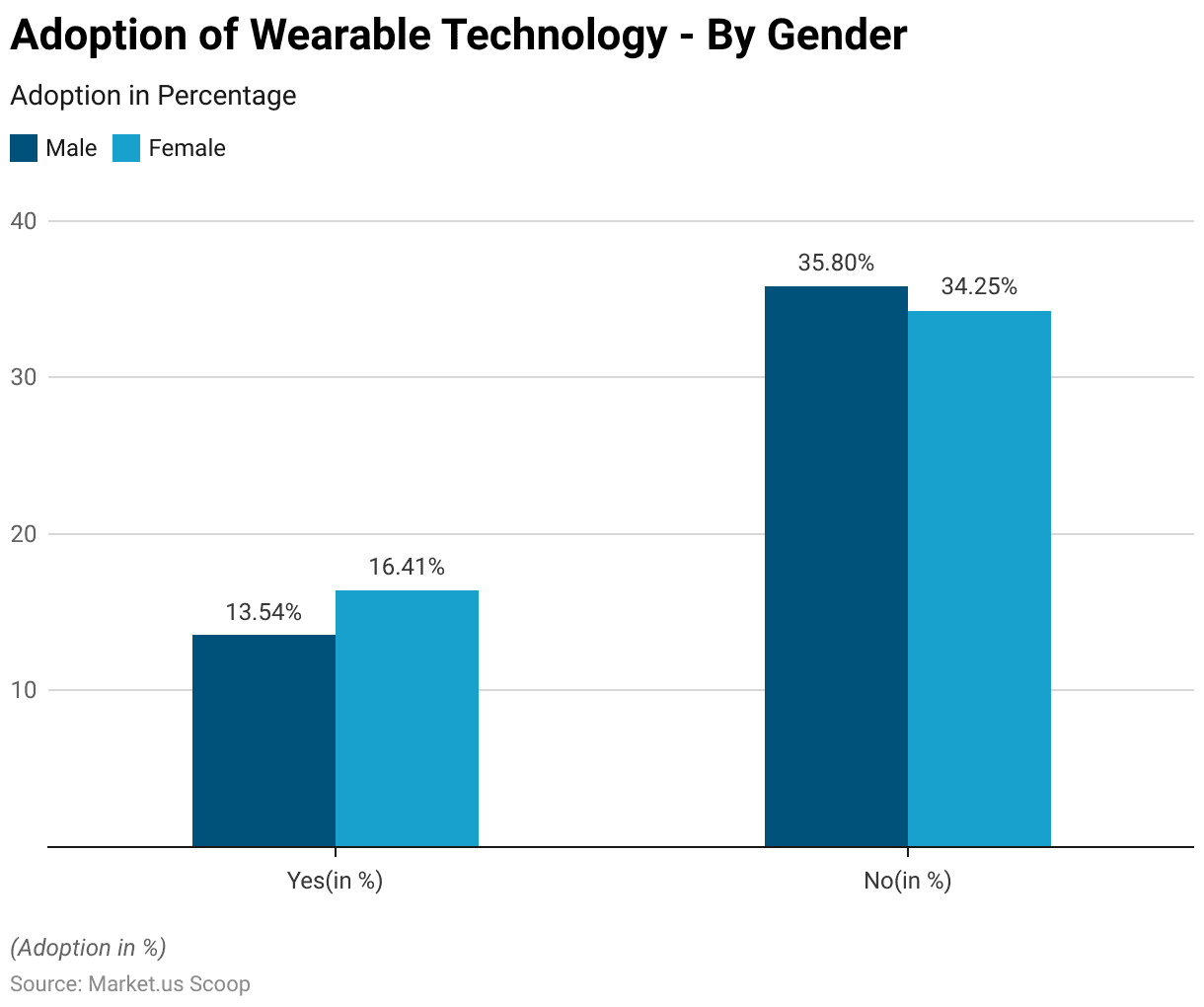
According to Education
- In the past 12 months, the utilization of wearable healthcare devices has shown interesting variations across different educational backgrounds.
- Among individuals with less than a high school education, a relatively low percentage of 0.78% have used such devices, while the majority, accounting for 4.14%, have not.
- In contrast, high school graduates exhibit a slightly higher adoption rate, with 3.49% reporting using wearable healthcare devices, while 18.24% have not utilized them.
- Moving on to those with some college education, the data indicates a significant increase in adoption, with 12.75% using these devices, while 28.54% have chosen not to.
- Interestingly, among individuals who are at least college graduates, 12.85% have embraced wearable healthcare technology, while 19.21% have not.
- These statistics suggest a positive correlation between higher levels of education and the adoption of wearable healthcare devices, with individuals holding at least a college degree being more likely to incorporate such technology into their health and wellness routines.
(Source: National Cancer Institute’s Health Information National Trends Survey)
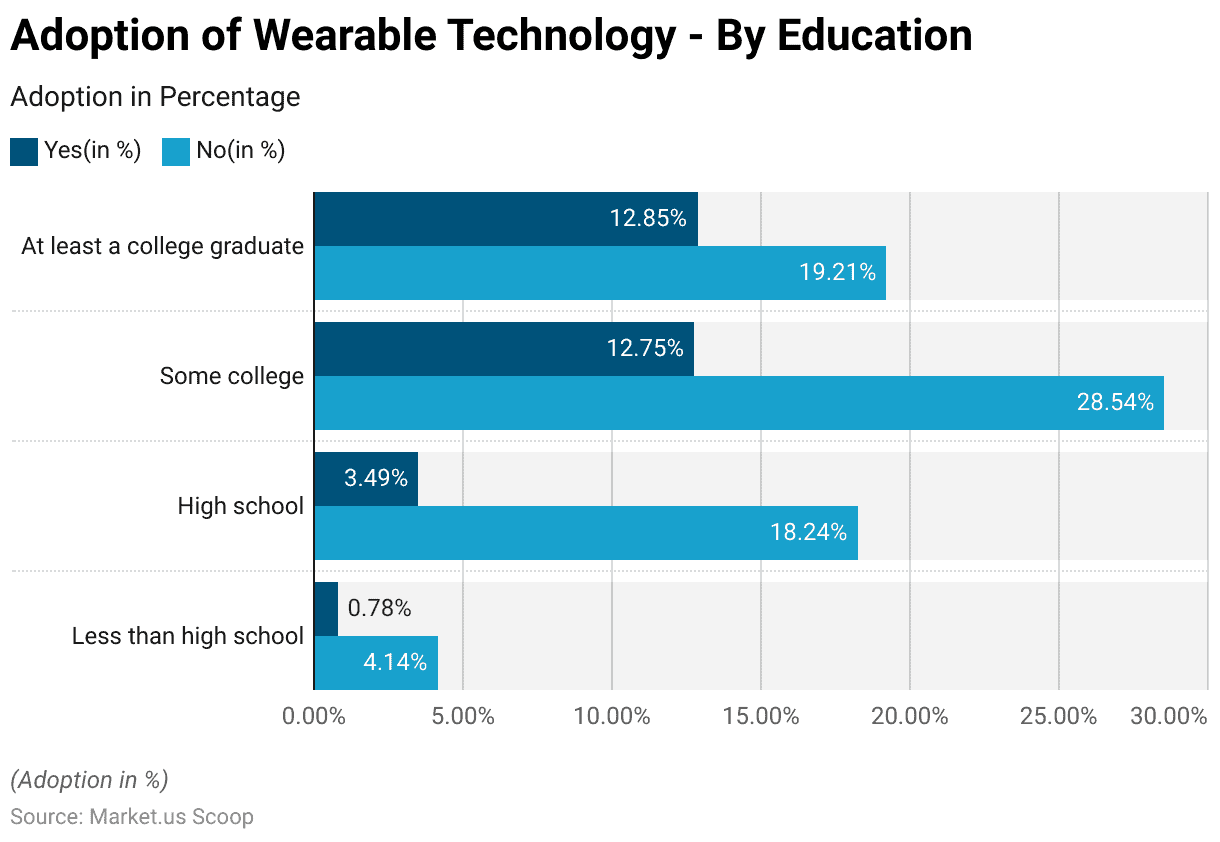
According to Income
- Approximately 34% of wearable technology users worldwide belong to the low-income category, while those in the medium-income group make up around 41% of the total wearable user base.
- Conversely, users from the high-income category constitute a smaller proportion, accounting for only about 25% of all wearable technology users globally.
(Source: SaaS Scout)
Consumer Response On Wearable Technology
- Approximately 40% of global wearable technology users find these devices indispensable, while 25% report wearing them even while sleeping.
- About 70% of users trust their favorite gadget manufacturers to prioritize data security, making these brands more reliable than internet and communication providers.
- Nearly 43% of wearable gadget users believe that smartphones will eventually be replaced by built-in wearable tech.
- Around 40% of wearable technology users feel more at ease using search technologies, reducing their smartphone usage in favor of smartwatches.
- By the end of 2020, 88% of users expect wearable devices to offer additional health and wellness features.
- Only 25% of purchasers with specific expectations express dissatisfaction with wearable products.
- Of all wearable technology purchasers, 74% prefer devices with sensors for enhanced interactions.
- By 2020, 30% of users had plans to incorporate five more wearables into their collection.
(Source: Statista)
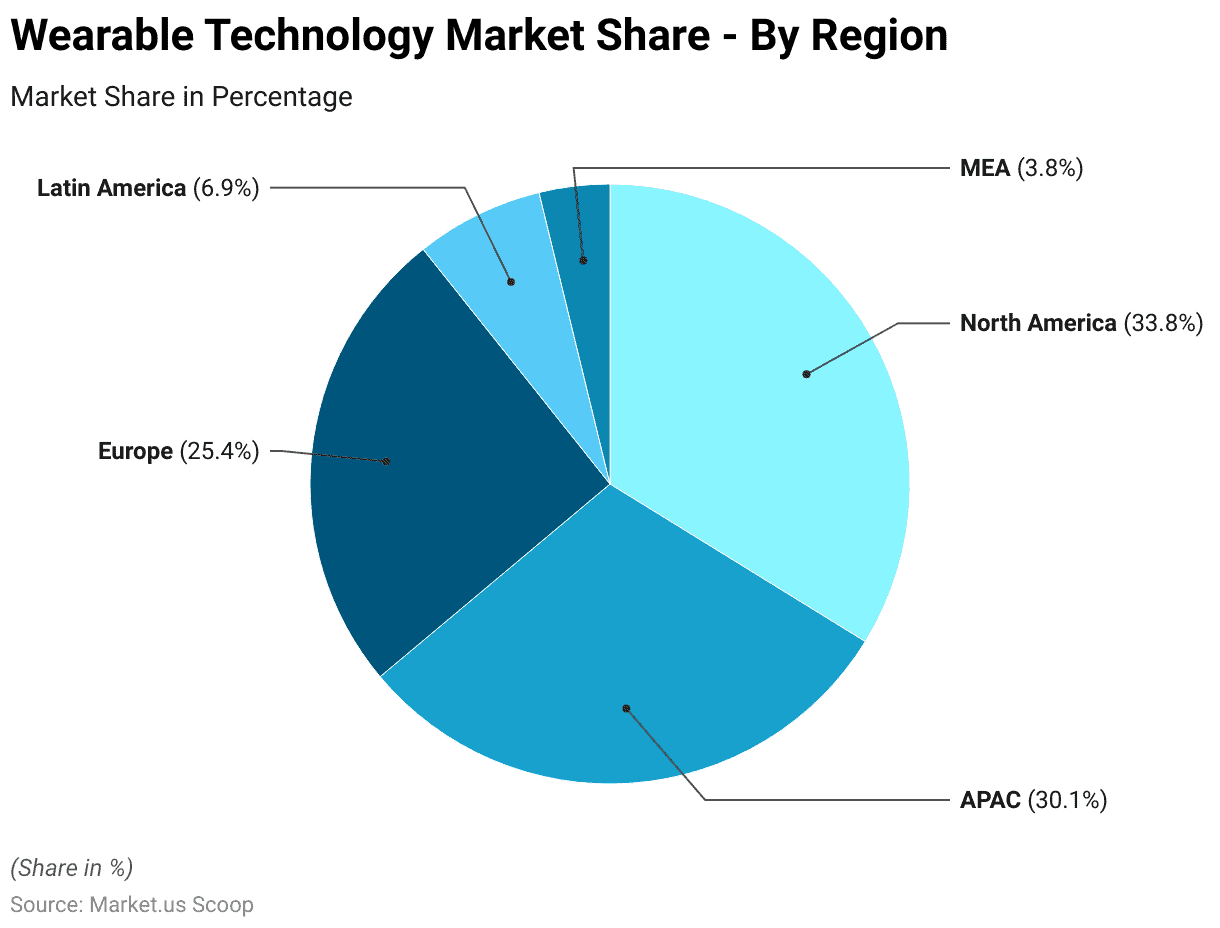
Shipments of Wearable Devices
- The wearable device market is characterized by several product categories, with “Earwear” emerging as the dominant segment in terms of shipment volume and market share.
- In 2023, Earwear devices will have 325 million shipments, commanding a substantial market share of 62.10%.
- This category is expected to continue its growth trajectory, reaching 404 million shipments and maintaining a significant market share of 62.70% by 2027, with a compound annual growth rate (CAGR) of 5.60% over the five years.
- Smartwatches also hold a substantial market share, with 162.2 million shipments and a 31.00% market share in 2023.
- They are anticipated to see steady growth, reaching 205.3 million shipments and maintaining a 31.90% market share in 2027, with a CAGR of 6.10%.
- In contrast, Wristbands exhibit a declining trend, with 33.8 million shipments and a 6.50% market share in 2023, projected to decrease to 31.7 million shipments and a 4.90% market share by 2027, reflecting a negative CAGR of –1.60%.
- Finally, the “Others” category, comprising various wearable devices, is expected to see notable growth, with 2.2 million shipments and a 0.40% market share in 2023, increasing to 3.5 million shipments and a 0.50% market share in 2027, driven by a robust CAGR of 12.50%.
- The wearable device market is forecasted to reach 523.2 million shipments in 2023 and grow to 644.5 million by 2027, with an overall CAGR of 5.40% during these five years.
(Source: IDC Worldwide Quarterly Wearable Device Tracker, March 7, 2023)
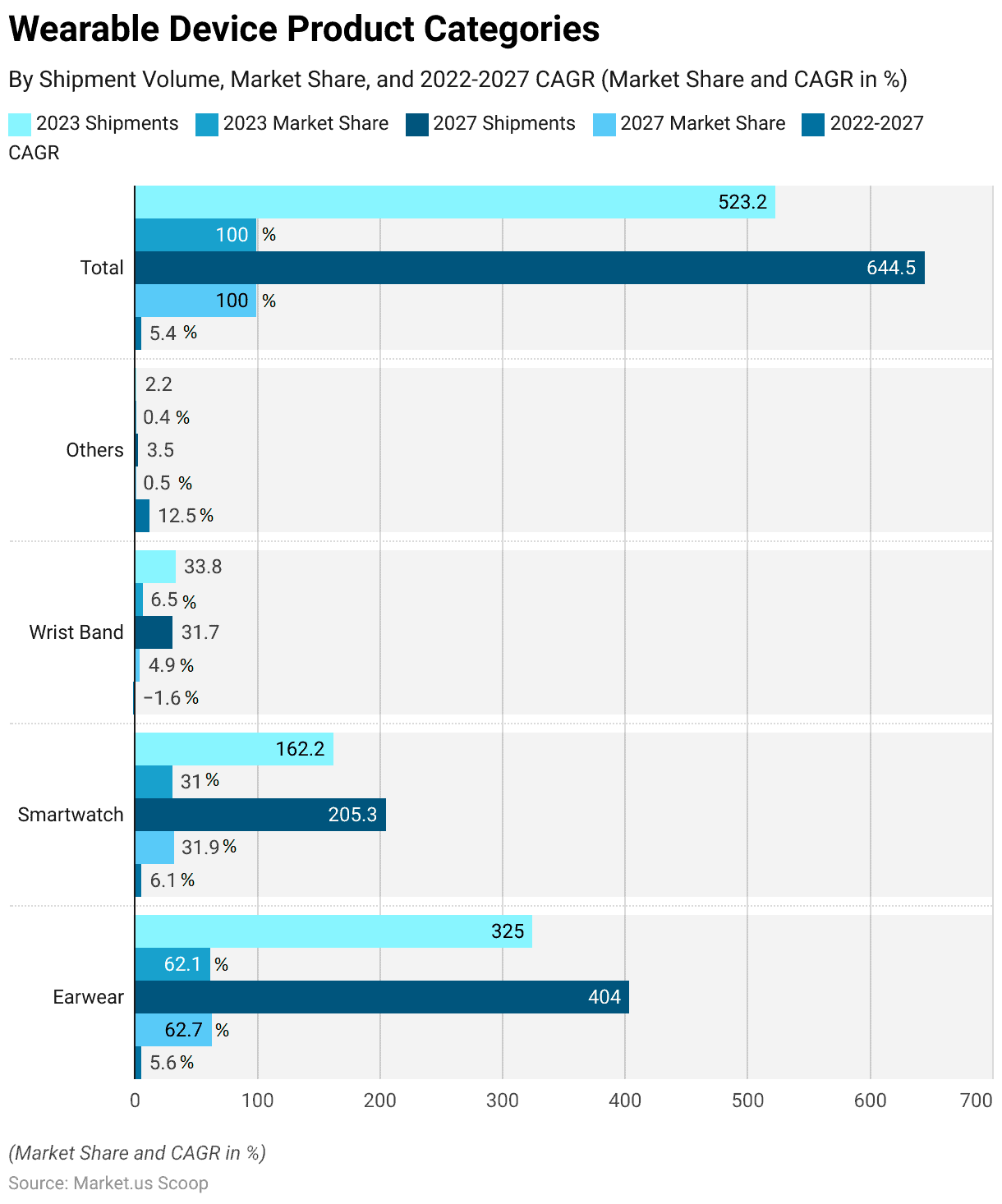
Global Spending on Wearable Devices
- The end-user spending on wearable devices worldwide witnessed significant growth across various categories from 2019 to 2022.
- Smartwatches led the way, with expenditures increasing from 18,501 million dollars in 2019 to 31,337 million in 2022.
- Similarly, ear-worn devices experienced substantial growth, rising from 14,583 million dollars in 2019 to 44,160 million dollars in 2022.
- In contrast, wristbands gradually declined spending, from 5,101 million dollars in 2019 to 4,477 million in 2022.
- Head-mounted displays and smart clothing also displayed growth in spending, with head-mounted displays going from 2,777 million dollars in 2019 to 4,573 million dollars in 2022 and smart clothing increasing from 1,333 million dollars in 2019 to 2,160 million dollars in 2022.
- Smart patches saw notable growth, rising from 3,900 million dollars in 2019 to 7,150 million in 2022.
- In total, the end-user spending on wearable devices globally surged from 46,194 million dollars in 2019 to 93,858 million dollars in 2022, reflecting the increasing adoption and diversification of wearable technology across different categories.
(Source: Gartner – Jan 2021)
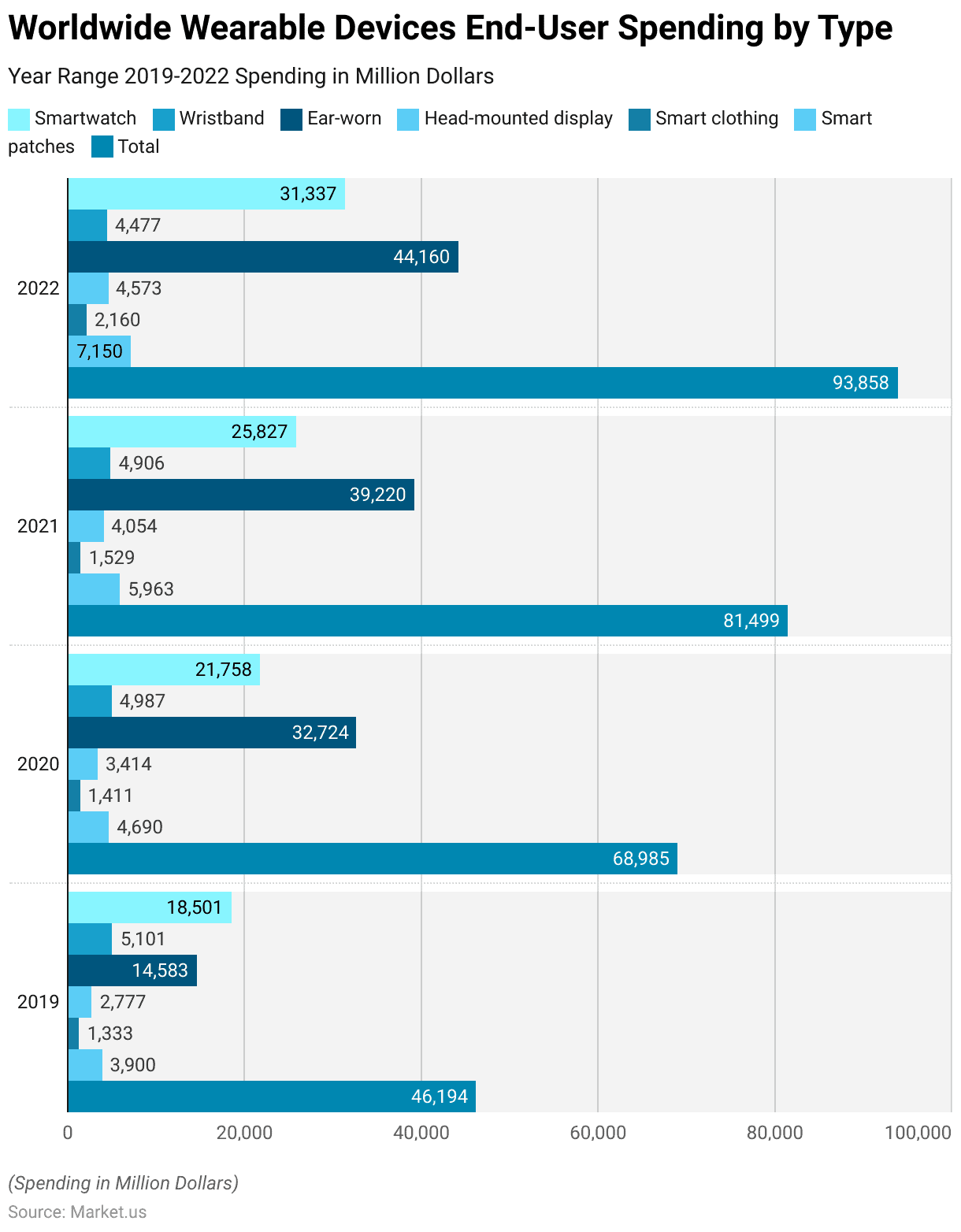
Wearable Technology Usage by Country
- The adoption of wearable technology varies across countries, with China leading the way, with 34% of its population using wearables.
- Close behind is India, where 33% of people have embraced wearable devices.
- In the United States, 32% of the population uses wearables, reflecting a strong presence in the tech-savvy nation.
- The United Kingdom follows with 27%, while Sweden and Canada stand at 25%.
- In the Netherlands, 20% of the population uses wearables, while Germany and South Korea report 19% and 17% adoption rates, respectively.
- Brazil rounds out the list, with 15% of its population using wearable technology.
- These statistics highlight the global diversity in wearable technology adoption, with certain countries showing a higher propensity for embracing this tech trend than others.
(Source: Statista)
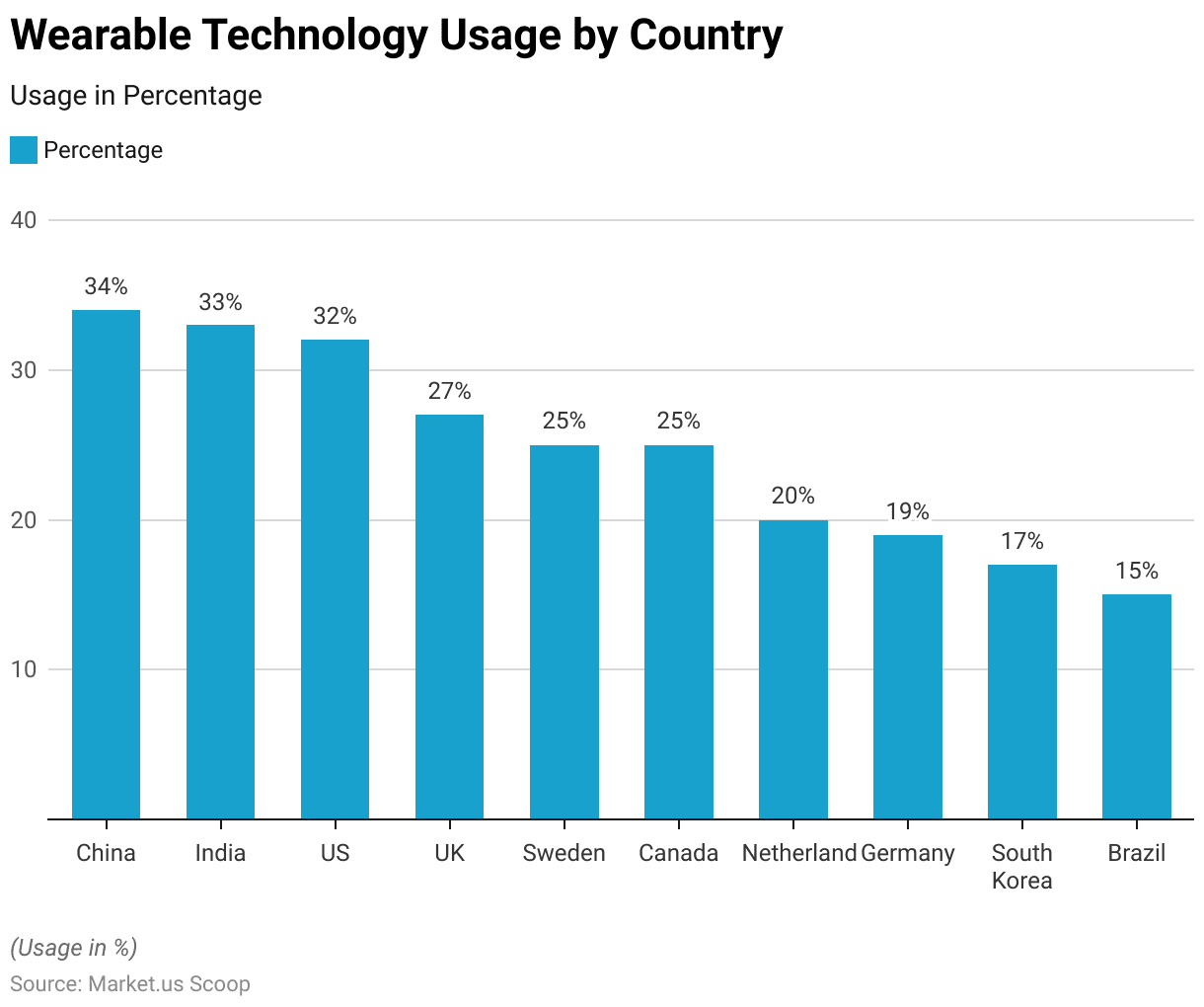
Barriers to Adoption of Wearables
- The reasons for individuals abandoning wearable technology devices are multifaceted.
- A significant portion, 21%, cited limited functionality and use as a primary factor leading to abandonment.
- Additionally, 14% mentioned that wearables weren’t standalone, indicating a desire for greater independence from other devices.
- A lack of inbuilt internet connectivity and inaccurate data or information were each reported by 9% of respondents, emphasizing the importance of reliable and connected functionality.
- Poor integration with smartphones and the availability of new devices with superior features also accounted for 9% of the responses, highlighting the need for seamless connectivity and continuous innovation.
- Battery drainage emerged as a concern for 8% of users, while 6% attributed abandonment to poor design and aesthetics.
- A smaller percentage found wearables complicated to use (4%), lacking in third-party apps (4%), or challenging to set up (4%).
- Finally, 3% cited various other reasons for discontinuing wearables.
- These responses underscore the diverse factors influencing user decisions to abandon wearable technology, ranging from functional limitations to design aesthetics and ease of use.
(Source: Ericsson ConsumerLab Survey)
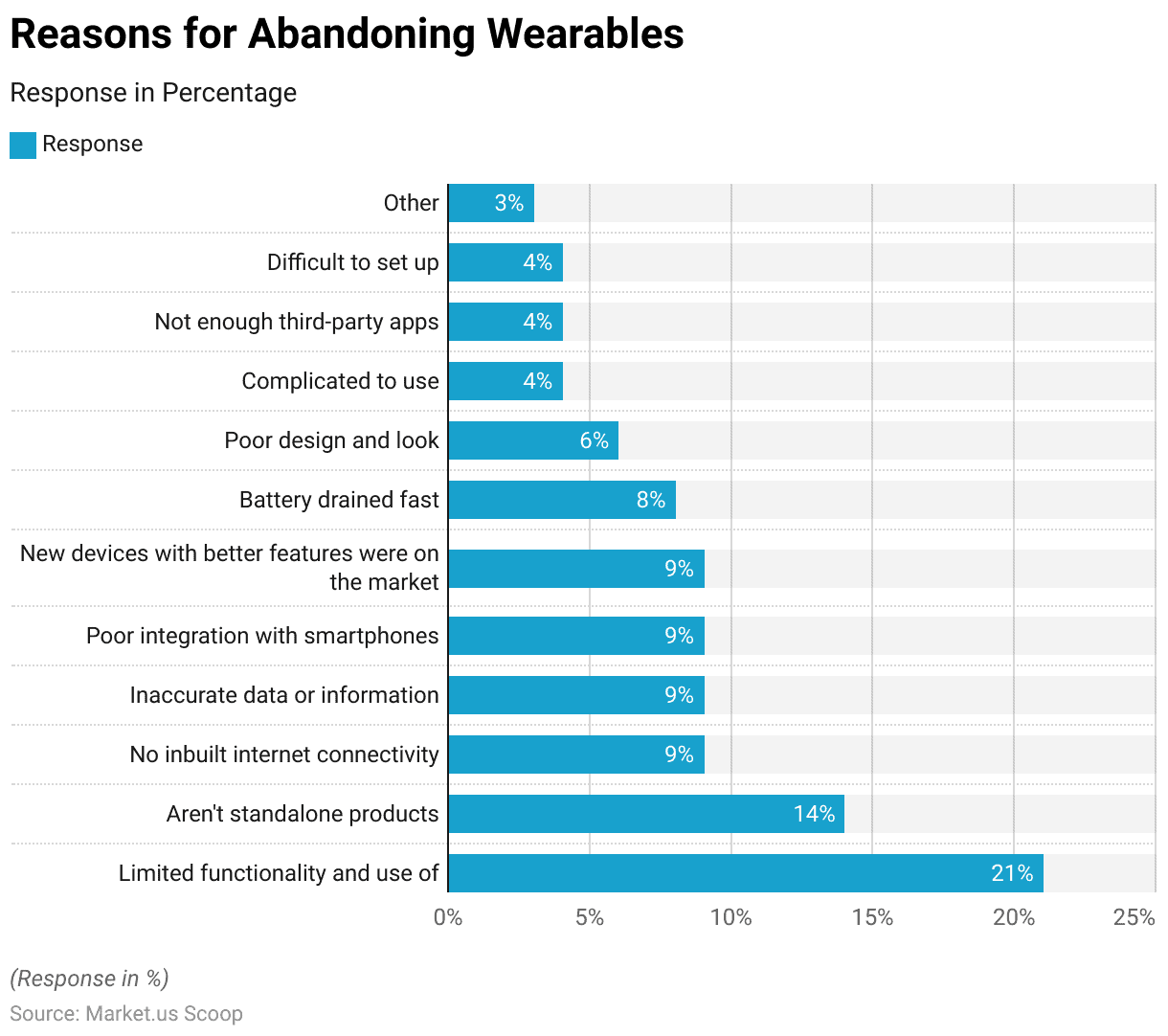
Recent Developments
Acquisitions and Mergers:
- Google acquires Fitbit: In early 2023, Google completed its $2.1 billion acquisition of Fitbit. This acquisition aims to enhance Google’s capabilities in the wearable tech market by integrating Fitbit’s health-tracking technology with Google’s AI and software ecosystem.
- Apple acquires Beddit: Apple acquired Beddit, a sleep monitoring technology company, for $50 million in mid-2023. This merger is expected to strengthen Apple’s health and wellness offerings by integrating advanced sleep-tracking features into its wearable devices.
New Product Launches:
- Apple Watch Series 8: In late 2023, Apple launched the Apple Watch Series 8, featuring enhanced health monitoring capabilities such as improved heart rate sensors, blood oxygen monitoring, and advanced sleep tracking.
- Samsung Galaxy Watch 5: Samsung introduced the Galaxy Watch 5 in early 2024, with new features including a more accurate body composition analysis, improved battery life, and enhanced integration with Samsung Health.
Funding:
- Oura Ring raises $100 million: Oura Health, the maker of the Oura Ring, secured $100 million in funding in 2023 to expand its product line and enhance its health-tracking features, focusing on sleep and activity monitoring.
- Whoop secures $200 million: In early 2024, Whoop, a company specializing in fitness and health wearables, raised $200 million to develop new products and improve its analytics platform, which provides insights into fitness, recovery, and sleep.
Technological Advancements:
- AI and Machine Learning Integration: Wearable devices are increasingly integrating AI and machine learning to provide more personalized health insights, predictive analytics, and real-time data processing, enhancing user experience and accuracy.
- Advanced Sensor Technologies: New sensor technologies are being developed to monitor a wider range of health metrics, including hydration levels, glucose monitoring, and stress levels, offering more comprehensive health tracking.
Market Dynamics:
- Growth in Wearable Technology Market: The global wearable technology market is projected to grow at a CAGR of 14.3% from 2023 to 2028, driven by increasing health consciousness, advancements in sensor technology, and the rise of remote health monitoring.
- Increased Adoption in Healthcare: Wearable technology is seeing increased adoption in healthcare for applications such as remote patient monitoring, chronic disease management, and telehealth, enhancing patient care and reducing healthcare costs.
Regulatory and Strategic Developments:
- FDA Approvals for Wearable Devices: The US Food and Drug Administration (FDA) approved several new wearable devices in 2023 and 2024, including smartwatches and fitness trackers with advanced health monitoring features, ensuring their safety and effectiveness for consumer use.
- EU’s Medical Device Regulation (MDR): The European Union’s MDR, implemented in 2023, includes specific requirements for wearable health devices to ensure they meet safety and performance standards, promoting consumer trust and market growth.
Research and Development:
- Wearable Technology for Chronic Diseases: R&D efforts are focusing on developing wearable devices to monitor and manage chronic diseases such as diabetes, cardiovascular diseases, and respiratory conditions, providing continuous health data and early warning signs.
- Flexible and Stretchable Electronics: Researchers are exploring flexible and stretchable electronics for wearables, allowing devices to conform to the body’s shape and movements, improving comfort and functionality.
Conclusion
Wearable Technology Statistics – In summary, wearable technology has truly come into its own as a dynamic and significant industry.
These wearable devices, created to be worn on our bodies, serve a wide range of purposes, from keeping tabs on our health to enhancing communication and providing convenience and entertainment.
This burgeoning field owes much of its growth to industry giants like Apple and Samsung. Of course, challenges like privacy issues, short battery life, and regulatory concerns have cropped up, but the ongoing drive for innovation is steadily tackling these obstacles.
Looking ahead, the future of wearable tech is filled with promise, including exciting trends like integrating artificial intelligence, incorporating electronic textiles, and expanding their role within the Internet of Things ecosystem.
As these wearables evolve and integrate into our daily routines, they can transform how we monitor our well-being, stay connected, and engage with technology.
FAQs
Wearable technology refers to electronic devices worn on the body, often designed to perform various functions such as tracking health metrics, enabling communication, enhancing convenience, or providing entertainment.
Examples include smartwatches, fitness trackers, augmented reality (AR) glasses, hearables (smart earbuds), medical wearables, smart clothing, and more.
Fitness trackers typically use sensors like accelerometers and heart rate monitors to collect data on your physical activity, sleep patterns, and health metrics. This data is then synced to a mobile app or computer for analysis and tracking.
Wearable tech can help you monitor your health, stay connected, track fitness goals, and simplify daily tasks. It also offers convenience and accessibility, especially for on-the-go activities.
Yes, privacy is a concern. Wearable devices collect personal data, so it’s important to remember how this information is stored and shared. Be sure to review privacy settings and permissions when using wearable technology.
Discuss your needs with our analyst
Please share your requirements with more details so our analyst can check if they can solve your problem(s)



